-

新人教版高中英语必修2Unit 3 The Internet-Reading and Thinking教案一
Paragraph 3. Jan decided to start an IT club to teach old people how to use computers and the Internet. Paragraph 4. Jan has started taking online classes to learn more about how to use the Internet to make society better. Paragraph 5. Jan’s life has been greatly improved by the Internet. Step 5: Critical thinking:(1)How do you arrange your time spent on study and the Internet? Is it reasonable? I usually surf the Internet using my mobile phone for only an hour after class, and it is reasonable for me.(2)What are your online activities? Are they safe? I chat with my friends, read news and play games. I never give away my private information so I think they are safe.Step 4: summary Much has been written about the wonders of the World Wide Web. There are countless articles (1)______(tell) us how the Internet has made our lives more convenient. But the Internet has done a lot (2)_____(much) for people than simply make life more convenient. People’s lives (3) _________________(change) by online communities and social networks so far. Take Jan for example, who developed a serious illness that made her (4)_____(stick) at home with only her computer to keep (5)___(she) company. She joined an online group (6)______ she could share problems, support and advice with others. She considered the ability to remove the distance between people as one of the greatest (7)_______(benefit). She was so inspired (8)____ she started an IT club in which many people have been helped. She has started to learn more about how to use the Internet to make society better. Her next goal is to start a charity website to raise money (9)___ children in poor countries. Jan’s life has been (10)______(great) improved by the Internet. Step 5 Homework:Review what we have learned and find out the key language points in the text.

新人教版高中英语必修2Unit 4 History and Traditions-Listening&Speaking&Talking教案二
Listening and Speaking introduces the topic of “Take part in a youth project”. The listening text is an interview about "sharing views on historical sites". Through listening to a dialogue between Chinese and foreign students on the way to the Confucius Temple, students can understand their views on the Confucius Temple, Confucius, Confucius' descendants and Confucius' educational thoughts, so as to realize and think about the profound influence of Confucius and his thoughts on Chinese historical tradition. At the same time, the dialogue naturally integrates English idioms and mentions Shakespeare, the British playwright, so as to provide language materials and context for students to understand English idioms and related cultural allusions, as well as to compare Chinese and foreign cultures, which is helpful for students to understand and express the language such as history, tradition, culture and custom significant impact.Text analysis: listening text is a dialogue between a British student and a Chinese student when he goes to the Confucius Temple. When William, a British student, visited the Confucius Temple, he asked Xiao Kong, a Chinese student, for directions. Xiao Kong was just going to the Confucius Temple to meet with the members of the research group, so they went together and exchanged their views on the Confucius Temple, Confucius, Confucius' descendants and Confucius' educational thoughts. From the perspective of foreign tourists, this paper describes their thoughts on Confucius, the great son of Confucius, who had a profound impact on Chinese history and cultural tradition, and his education.Listening and Talking introduces a visit to a historic tourist destination. Tourism is a common way to understand a country's history, culture, and customs and so on. Students listen to the dialogue between Xiao Yan, a youth hostel Usher, and Paul, a backpacker, to learn about Pingyao's famous historical and cultural attractions and Paul's travel experience and experience as a foreign tourist.

新人教版高中英语必修2Unit 5 Music-Discovering Useful Structures教案一
Step1:自主探究。1.(教材P52)Born(bear) in the USA on 2 January 1970, Whitacre began studying music at the University of Nevada in 1988.2.(教材P52) Moved(move) by this music, he said, “It was like seeing color for the first time.”3.(教材P56)I was very afraid and I felt so alone and discouraged(discourage).4.(教材P58)Encouraged(encourage) by this first performance and the positive reaction of the audience, I have continued to play the piano and enjoy it more every day.Step2:语法要点精析。用法1:过去分词作表语1).过去分词可放在连系动词be, get, feel, remain, seem, look, become等之后作表语,表示主语所处的状态Tom was astonished to see a snake moving across the floor.汤姆很惊讶地看到一条蛇正爬过地板。Finally the baby felt tired of playing with those toys.终于婴儿厌倦了玩那些玩具。注意:1).过去分词作表语时与被动语态的区别过去分词作表语时,强调主语所处的状态;而动词的被动语态表示主语是动作的承受者,强调动作。The library is now closed.(状态)图书馆现在关闭了。The cup was broken by my little sister yesterday.(动作)昨天我妹妹把杯子打碎了。2)感觉类及物动词的现在分词与过去分词作表语的区别过去分词作表语多表示人自身的感受或事物自身的状态,常译作“感到……的”;现在分词多表示事物具有的特性,常译作“令人……的”。

新人教版高中英语选修1Unit 3 Fascinating Parks教案
2. Explore the significance of the establishment of Sarek National Park.Q1: Which event is the most important one in the park’s history?Ss: The establishment of Sarek national park in 1909 is the most important one.Q2: Is it worth making a place like Sarek a national park? Give your reasons.Ss: Yes. In this way, the place can be kept in its natural state and natural beauties and other rare and valuable resources can be preserved instead of being destroyed by endless exploitation driven by profits.Q3: How does the writer organize his introduction to the history of Sarek?Ss: The writer organizes his introduction in the sequence of time, using time indicators such as “used to”, “around 9,000 years ago”, “soon after”, “following the reindeer”, and “in 1909”.Q4: What is the feature of the language used to introduce the history of the park?Ss: The introduction to the park is to provide facts, using time indicators to organize the events. Sentences starts with “third person” and passive voice is used more often, feeling objective.【设计意图】学生寻找和梳理公园历史上的重要事件,体会人与自然的和谐关系,评鉴介绍性语言的特点。【核心素养提升点】发展自主提取、梳理文本信息能力,训练逻辑思维和高阶思维。Activity 3: Highlighting the secret of the text
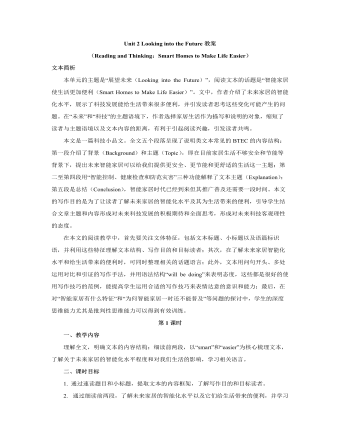
新人教版高中英语选修1Unit 2 Looking into the Future教案
【设计意图】以“新科技是一把双刃剑”为主题开展讨论活动。这个话题比较大,所以给了一定的限制,首先需要以智能家居为例来阐述科技发展对未来生活产生的影响,然后列举其优点和缺点,最后就以上现象发表自己的观点。这个活动是对整个文本的创意性总结与意义的升华,留给学生一定的想象空间,学生借此机会可以运用文本内容和语言表达自己对科技发展的看法和态度。Assignments:1. Finish Exercise 4 on Page 15 of the textbook.A smart home is one that integrated computers into the structure of the building itself. In this way, many of the things that we now do ourselves become automatic. For example, the smart home could control the air conditioning and lights so that you would no longer have to turn switches on and off, and so that your home would be more energy-efficient. The smart home could also monitor itself to make sure that everything is working as it should, and send you warnings if there is a problem. Such smart homes could even be programmed to detect your health problems, and then give you reasonable advice as to the food you should eat or if you should see a doctor. So, in a sense, smart homes will lead us to living smarter lives.2.Create a smart function for your home, and share your creation in the next period.
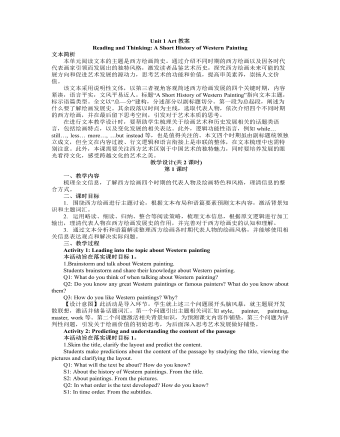
新人教版高中英语选修3Unit 1 Art教案
[2] An important breakthrough…was… [3] Another innovation was … [4] the emphasis increasingly shifted from…to… [5] New ideas and values gradually replaced… [6] While his paintings still had religious themes… … T: All these expressions serve to show how Western painting has developed. Some of them share similar structure but with varied use of words, which makes the text vivid and more readable. 【设计意图】主题类语言整理有助于学生类化语言应用,提高语言输出的丰富性。处理完文本内容信息后,进入语篇信息处理,进行主题相关的词块归类。引导学生快速阅读,寻找表达相同主题(发展或者艺术)的词和短语,再根据词性、用法和结构进行归类,储备主题相关词汇,丰富语言储备,提升语言素养。 Assignment: Go online to gather more information about Chinese painting and write a short history of it. 【设计意图】结合所学,迁移运用,根据实际语境,进行模仿性运用。在此过程中,学生尝试借鉴已学的语言、内容、语篇结构和写作手法来建构新文本,实现语篇输出,同时关注中西艺术文化的差别,加深对优秀文化的认同,培养文化意识。

新人教版高中英语选修3Unit 2 Healthy Lifestyle教案
Activity 4: Figuring out the structure and the writing purpose 本活动为实现课时目标2。 1.Read Paragraph 6 and think about its main idea and the writer’s writing purpose. Q1: If you were the author, how would you end your article? “For young people, there is plenty of time to change bad habits. However, there is no “magic pill” or delete button that will help you; you have to think about your bad habits and decide on some changes. You have the power to build a happy and healthy life full of good habits!” Q2: What is Paragraph 6 mainly about? (Possible answer: to appeal to young people including teenagers to change bad habits and live a happy and healthy life.) 2.Think about the writer’s writing purpose and share opinions. Q1: What is the writing purpose? Work in pairs and figure it out. (Possible answer: On the one hand, the passage is written to help teenagers change their bad habits and live a healthy lifestyle. On the other hand, it provides us with a scientific way to identify and analyse our problems objectively, thus strengthening our resolve to tackle the seemingly common yet tough problems in our lives.) 【设计意图】 步骤1旨在预测和验证文章最后一段主要内容,梳理完整的语篇结构,步骤2旨在思考和讨论作者的写作目的。教师也可根据学生课堂反应情况融入对语篇人称多次转换的思考。

新人教版高中英语选修4Unit 2 Iconic Attractions教案
帮助学生通过讨论与对主题的提升,反思自己的旅游方式,以便做出更优化的安排,在今后的旅程中有更多的收益。 Activity 2: Further discussion of the 6 elements above and supplement of more background knowledge 本活动为实现课时教学目标2。 1.Target Q: The writer’s clear target of traveling, meeting the people and experiencing the culture, is closely related to his major in social studies. Then what is social studies? Social studies is a part of a school or college curriculum concerned with the study of social relationships and the functioning of society and usually made up of courses in history, government, economics, civics, sociology, geography, and anthropology. (Dictionary by Merriam-Webster) Reflection: When you go out to travel, what targets do you usually have in mind? 2.Research Q: Suppose you are traveling to Hangzhou during the school holidays, how will you do research on the city? (surf the internet, read books or travel brochures, consult friends, ...) What information will you be interested to know? (location, iconic sites, local cuisines, interesting customs, shopping malls ...) 3.Abandonment To make the most of time, we have to learn to abandon so that we can accomplish our plan. What will you be interested in doing if you go to Hangzhou if you have a week’s time? What if you only have 2 days? 4~5. Venturing & Experiencing Q: What did he venture to do during the trip? What new experiences did he have? In Sydney: attend his first open-air barbecue, enjoy many different but yummy meals In Catherine: observe the life and customs of the aborigines appreciate their music & try the musical instruments: the didgeridoo

新人教版高中英语选修4Unit 4 Sharing教案
【核心素养提升点】学会将抽象信息进行可视化表达,提高信息处理能力和分析、推理等高阶思维品质;在跨文化交际中学会以国际视野接受和包容不同的文化。 5.Read Paragraph 2, draw a mind map and answer the questions. Q1:What did Jo learn about Tombe’s life? Q2:What kind of life do the natives lead? Read paragraph 2-5 and draw a mind-map. (Focus on accommodation, possession, diet and belief) 【设计意图】引导学生利用思维导图和问题链等形式来厘清当地人的生活方式,更好地处理和归纳信息 【核心素养提升点】提高信息处理能力、分析和归纳能力,包容异国文化、扩展国际视野。 6.Read Paragraph 3 and answer the questions. Q1:What was Jo’s feeling upon arriving her own home? Q2:Why would she feel that way? Q3:Do you think “It was such a privilege to have spent a day with Tombe’s family”? 【设计意图】通过提问,让学生理解Jo的苦并快乐的心情,并通过对“It was such a privilege to have spent a day with Tombe’s family”这句话的理解,体验志愿者生活的伟大。 【核心素养提升点】学会对信息的综合和归纳,从而理解作者所表达的观点。 Activity4: Summarize the change of Jo's feelings
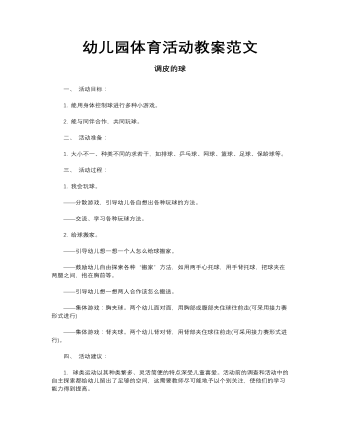
幼儿园体育活动教案
三、 活动过程: 1. 我会玩球。 ——分散游戏,引导幼儿各自想出各种玩球的方法。 ——交流、学习各种玩球方法。 2. 给球搬家。 ——引导幼儿想一想一个人怎么给球搬家。 ——鼓励幼儿自由探索各种“搬家”方法,如用两手心托球,用手背托球,把球夹在两腿之间,抱在胸前等。 ——引导幼儿想一想两人合作该怎么搬送。
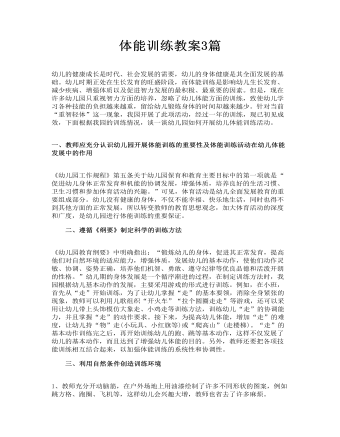
体能训练教案3篇
一、教师应充分认识幼儿园开展体能训练的重要性及体能训练活动在幼儿体能发展中的作用 《幼儿园工作规程》第五条关于幼儿园保育和教育主要目标中的第一项就是“促进幼儿身体正常发育和机能的协调发展,增强体质,培养良好的生活习惯、卫生习惯和参加体育活动的兴趣。”可见,体育活动是幼儿全面发展教育的重要组成部分。幼儿没有健康的身体,不仅不能幸福、快乐地生活,同时也得不到其他方面的正常发展,所以转变教师的教育思想观念,加大体育活动的深度和广度,是幼儿园进行体能训练的重要保证。

幼儿园中班体育教案
活动目标: 1、练习听信号变换速度奔跑,发展动作的灵活性和敏捷性。 2、体验运动后身体变热,培养幼儿的合作能力。 活动准备:雪花头饰。音乐磁带、儿歌--冬天到 活动过程: 1、热身运动:听音乐,全体幼儿扮雪花分散在场地上,一边念儿歌《冬天到》冬天到,雪花飘。我们跟着雪花跑,不怕风,不怕冷。冬天锻炼身体好。一边跟着老师轻轻的飞。
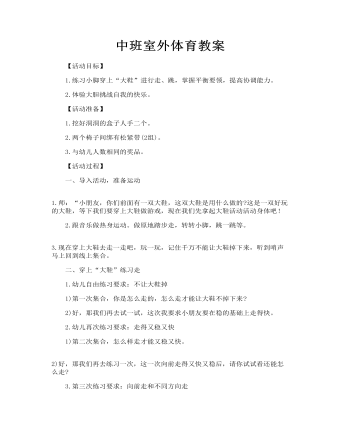
中班室外体育教案
一、导入活动,准备运动 1.师:“小朋友,你们前面有一双大鞋,这双大鞋是用什么做的?这是一双好玩的大鞋,等下我们要穿上大鞋做游戏,现在我们先拿起大鞋活动活动身体吧! 2.跟音乐做热身运动。做原地踏步走,转转小脚,跳一跳等。 3.现在穿上大鞋去走一走吧,玩一玩,记住千万不能让大鞋掉下来,听到哨声马上回到线上集合。 二、穿上“大鞋”练习走 1.幼儿自由练习要求:不让大鞋掉 1)第一次集合,你是怎么走的,怎么走才能让大鞋不掉下来? 2)好,那我们再去试一试,这次我要求小朋友要在稳的基础上走得快。 2.幼儿再次练习要求:走得又稳又快
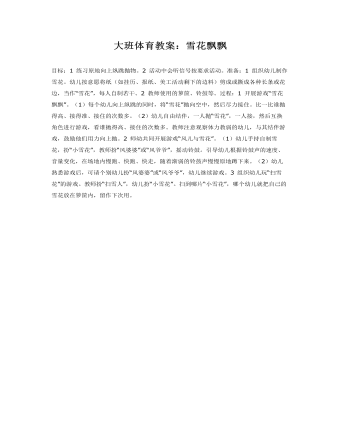
大班体育教案:雪花飘飘
2 教师使用的箩筐、铃鼓等。过程:1 开展游戏“雪花飘飘”。(1)每个幼儿向上纵跳的同时,将“雪花”抛向空中,然后尽力接住。比一比谁抛得高、接得准、接住的次数多。(2)幼儿自由结伴,一人抛“雪花”,一人接,然后互换角色进行游戏,看谁抛得高、接住的次数多。教师注意观察体力教弱的幼儿,与其结伴游戏,鼓励他们用力向上抛。2 师幼共同开展游戏“风儿与雪花”。
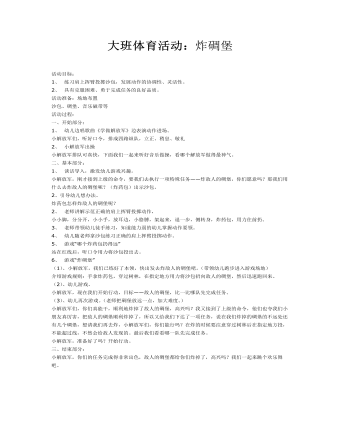
大班体育教案:炸碉堡
活动过程: 一、开始部分: 1、 幼儿边唱歌曲《学做解放军》边表演动作进场。 小解放军们,听好口令,排成四路纵队,立正、稍息、敬礼 2、 小解放军出操 小解放军排队可真快,下面我们一起来听好音乐做操,看哪个解放军做得最神气。 二、基本部分: 1、 谈话导入,激发幼儿游戏兴趣。 小解放军,刚才接到上级的命令,要我们去执行一项特殊任务——炸敌人的碉堡,你们愿意吗?那我们用什么去炸敌人的碉堡呢?(炸药包)出示沙包。 2、引导幼儿想办法。 炸药包怎样炸敌人的碉堡呢?
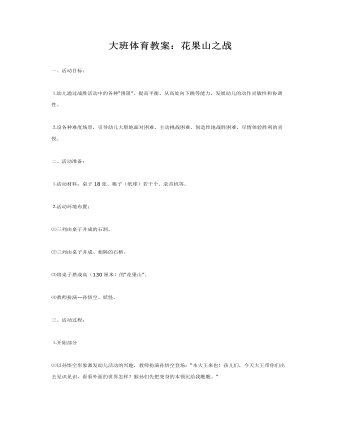
大班体育教案:花果山之战
⒉设各种难度场景,引导幼儿大胆地面对困难、主动挑战困难、创造性地战胜困难,尽情体验胜利的喜悦。二、活动准备:⒈活动材料:桌子18张、桃子(纸球)若干个、录音机等。⒉活动环境布置:⑴三列由桌子并成的石洞。⑵三列由桌子并成、相隔的石桥。⑶将桌子搭成高(130厘米)的“花果山”。⑷教师扮演—孙悟空、妖怪。
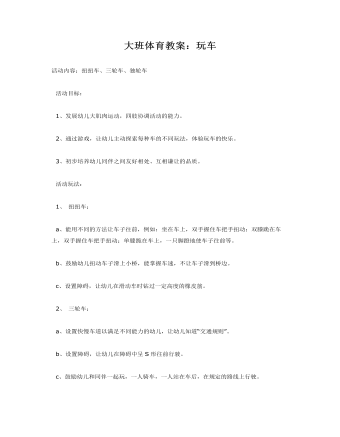
大班体育教案:玩车
活动目标: 1、发展幼儿大肌肉运动,四肢协调活动的能力。 2、通过游戏,让幼儿主动探索每种车的不同玩法,体验玩车的快乐。 3、初步培养幼儿同伴之间友好相处、互相谦让的品质。 活动玩法: 1、扭扭车: a、能用不同的方法让车子往前,例如:坐在车上,双手握住车把手扭动;双膝跪在车上,双手握住车把手扭动;单膝跪在车上,一只脚蹬地使车子往前等。

大班体育教案:玩瓶子
活动目标:1、玩雪碧瓶,发展跳跃能力、臂力以及机体的协调能力。2、培养团结协作精神,发展创造性思维能力。3、体验运动带来的快乐情绪。活动准备:幼儿每人一只雪碧瓶,内装大半瓶水;音乐一段。活动过程:一、准备动作幼儿听音乐模仿各种小动物的动作。(准备活动不仅让幼儿进行了走、跑、跳等的预备练习,而且激发了幼儿的学习兴趣,引起了幼儿的活动需求。)
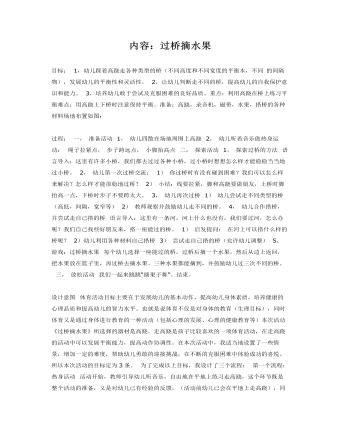
大班体育教案:过桥摘水果
过程: 一,准备活动 1,幼儿四散在场地周围上高跷 2,幼儿听着音乐做热身运动: 绳子拉紧点,步子跨远点,小脚抬高点 二,探索活动 1,探索过桥的方法 语言导入:这里有许多小桥,我们都去过过各种小桥,过小桥时想想怎么样才能稳稳当当地过小桥。 2,幼儿第一次过桥交流: 1)你过桥时有没有碰到困难?我们可以怎么样来解决?怎么样才能很稳地过桥? 2)小结:线要拉紧,脚和高跷要做朋友,上桥时脚抬高一点,下桥时步子不要跨太大。 3,幼儿再次过桥 1)幼儿尝试走不同类型的桥(高低,间隔,宽窄等) 2)教师观察并鼓励幼儿走不同的桥。 4,幼儿合作搭桥,并尝试走自己搭的桥 语言导入:这里有一条河,河上什么也没有,我们要过河,怎么办呢?我们自己找些好朋友来,搭一座能过的桥。 1)启发提问:在河上可以搭什么样的桥呢? 2)幼儿利用各种材料自己搭桥 3)尝试走自己搭的桥(允许幼儿调整) 5,游戏:过桥摘水果 每个幼儿选择一座能过的桥,过桥后摘一个水果。然后从边上返回,把水果放在篮子里,再过桥去摘水果。三种水果都能摘到,并鼓励幼儿过三次不同的桥。 三,放松活动 我们一起来跳跳“摘果子舞”。结束。
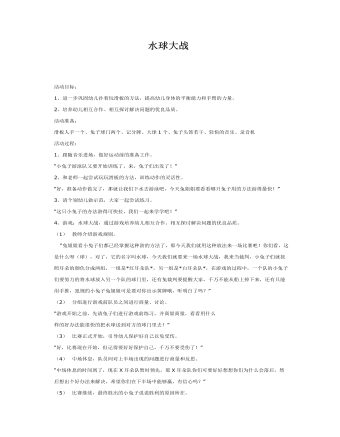
大班体育教案:水球大战
2、培养幼儿相互合作、相互探讨解决问题的优良品质。 活动准备: 滑板人手一个、兔子球门两个、记分牌、大球1个、兔子头饰若干、轻快的音乐、录音机 活动过程: 1、跟随音乐进场,做好运动前的准备工作。 “小兔子游泳队又要开始训练了,来,兔子们出发了!” 2、和老师一起尝试玩玩滑板的方法,训练动作的灵活性。 “好,准备动作做完了,那就让我们下水去游泳吧,今天兔姐姐要看看哪只兔子用的方法游得最快!” 3、请个别幼儿做示范,大家一起尝试练习。 “这只小兔子的办法游得可快拉,我们一起来学学吧!” 4、游戏:水球大战,通过游戏培养幼儿相互合作、相互探讨解决问题的优良品质。

